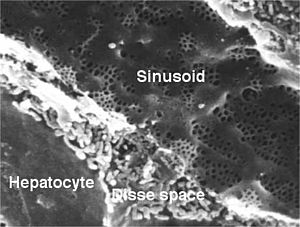Disse space

The Disse space is an approximately 10-15 µm wide anatomical space between the enlarged liver capillaries (liver sinusoids ) and the liver cells ( hepatocytes ). It is named after the German anatomist Joseph Disse (1852–1912).
Since the liver sinusoids have a discontinuous endothelium without a basement membrane , the blood plasma can pass directly into the disse space. The microvilli of the hepatocytes protrude into the Disse space , through which proteins, low molecular weight compounds and fluids are absorbed into the liver cells. The fluid in the Disse space oozes out through lymphatic vessels in the portal fields. In the Disse space there are a special kind of stellate cells called Ito cells .
Since the oncotic pressure in the liver sinusoids and the Disse space has hardly any gradient, lymph production is dependent on the pressure in the sinusoids. If the sinusoidal pressure increases by 1 mmHg, the lymph production doubles. If the transport capacity of the lymph vessels is exceeded, for example in the case of portal hypertension , ascites develops as the lymph enters the abdominal cavity .
literature
- Walter Siegenthaler : Clinical Pathophysiology. 9th edition. Georg Thieme Verlag, 2006, ISBN 3-13-449609-7 , p. 861.